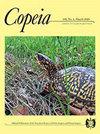The Eye Size of the Bluefin Killifish (Lucania goodei) Varies from Springs to Swamps
IF 2.6
Q2 Agricultural and Biological Sciences
引用次数: 2
Abstract
Variation in lighting environments creates different demands of visual systems for the successful detection and interpretation of visual signals. Eye size is a critical property of the visual system as it has strong effects on visual acuity and visual sensitivity. While many comparative studies have examined eye size across fishes that live in disparate lighting environments (i.e., caves versus surface habitats, mesopelagic versus pelagic depths, turbid versus clear water, diurnal versus nocturnal), fewer have investigated differences in eye size as a function of water clarity at the among-population level. Here, we compared relative eye size (eye size residuals on standard length) among wild-caught Bluefin Killifish (Lucania goodei) from tannin-stained swamps and clear springs across four drainages in Florida. We also performed a laboratory rearing experiment where we reared animals in clear and tea-stained water, which mimic spring and swamp conditions, to determine whether phenotypic plasticity as a function of lighting conditions influences relative eye size. Field caught animals varied greatly in relative eye size among populations, but there was no clear relationship with lighting environment. Fish from the two southern drainages (Everglades, Withlacootchee) had greater relative eye size than two northern drainages (Suwannee, North Florida). However, the results of our laboratory rearing experiment indicated that fish reared in clear water had slightly larger eyes compared to those in tea-stained water. While there are small effects of lighting environment on eye size, there are additional unknown genetic and environmental/ecological factors that influence adult eye size.蓝鳍鳉鱼(Lucania goodei)的眼睛大小因泉水和沼泽而异
照明环境的变化对视觉系统产生了不同的要求,以成功地检测和解释视觉信号。眼睛的大小是视觉系统的一个关键属性,因为它对视觉敏锐度和视觉灵敏度有很强的影响。虽然许多比较研究已经检查了生活在不同光照环境中的鱼类的眼睛大小(即,洞穴与水面栖息地,中深海与远洋深处,浑浊与清澈的水,白天与夜间),但很少有研究在种群水平上研究眼睛大小的差异作为水清晰度的函数。在这里,我们比较了在佛罗里达州四个排水管道中从单宁污染的沼泽和清澈的泉中捕获的野生蓝鳍鳉(Lucania goodei)的相对眼睛大小(标准长度上的眼睛大小残差)。我们还进行了一个实验室饲养实验,我们在清澈和茶渍的水中饲养动物,模拟春天和沼泽的条件,以确定表型可塑性是否作为光照条件的功能影响相对眼睛大小。野外捕获动物的相对眼大小在种群间差异较大,但与光照环境关系不明显。来自南部两个流域(Everglades, Withlacootchee)的鱼比北部两个流域(Suwannee, North Florida)的鱼眼睛的相对尺寸更大。然而,我们的实验室饲养实验结果表明,在清水中饲养的鱼的眼睛比在茶水中饲养的鱼的眼睛稍大。虽然光照环境对眼睛大小的影响很小,但还有其他未知的遗传和环境/生态因素会影响成人的眼睛大小。
本文章由计算机程序翻译,如有差异,请以英文原文为准。
求助全文
约1分钟内获得全文
求助全文
来源期刊

Copeia
生物-动物学
CiteScore
2.10
自引率
0.00%
发文量
0
审稿时长
6-12 weeks
期刊介绍:
Founded in 1913, Copeia is a highly respected international journal dedicated to the publication of high quality, original research papers on the behavior, conservation, ecology, genetics, morphology, evolution, physiology, systematics and taxonomy of extant and extinct fishes, amphibians, and reptiles. Copeia is published electronically and is available through BioOne. Articles are published online first, and print issues appear four times per year. In addition to research articles, Copeia publishes invited review papers, book reviews, and compiles virtual issues on topics of interest drawn from papers previously published in the journal.
 求助内容:
求助内容: 应助结果提醒方式:
应助结果提醒方式:


